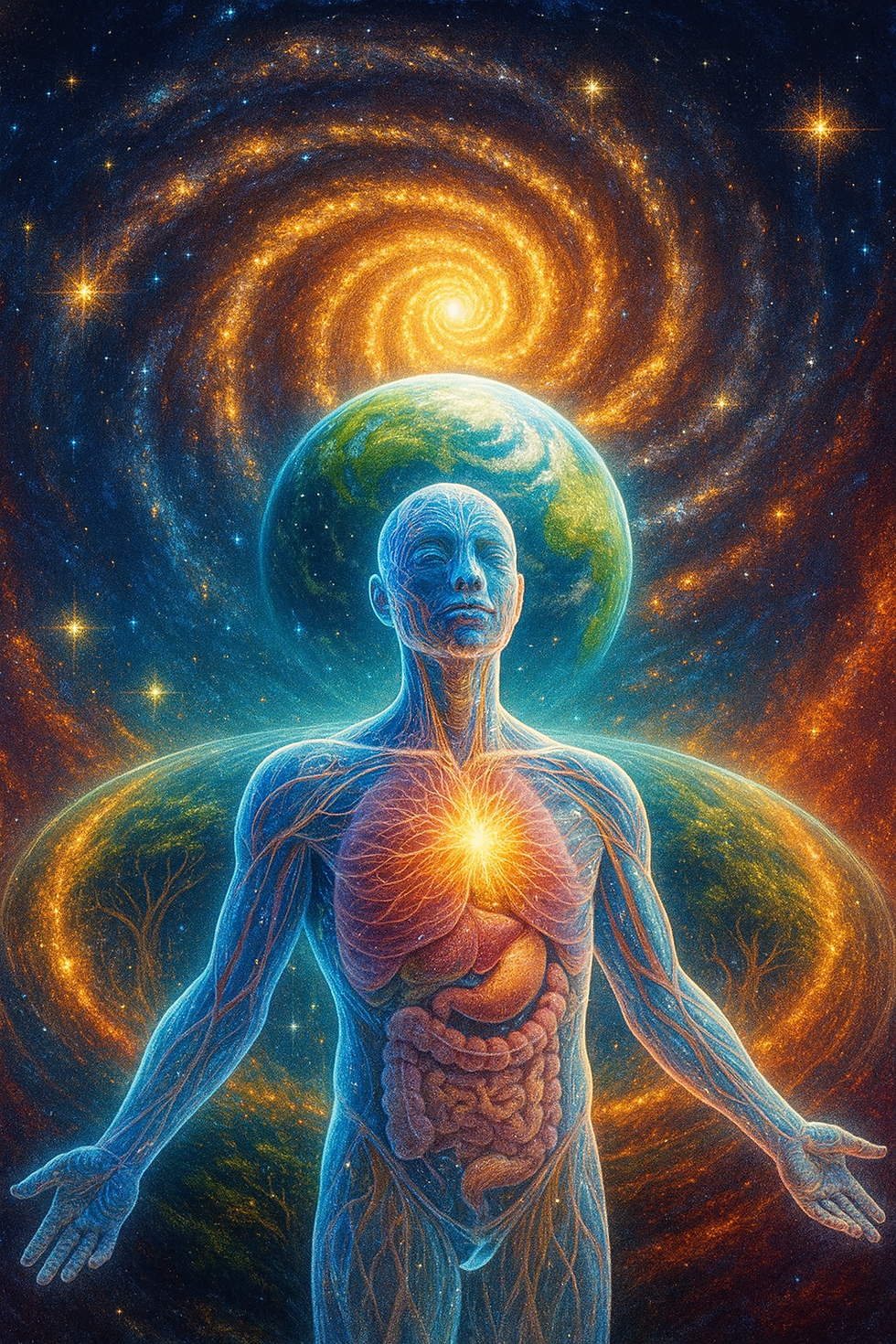From Quarks to Code: Evolution as the Self-Organizing Principle of the Cosmos
- 4marcusrobinson
- 6 days ago
- 4 min read
By Dr. Marcus Robinson | DCH IHP QBH

Introduction
The story of the universe is not one of randomness, but of emergence. At every scale—from the quantum to the ecological to the technological—forces converge to create new layers of complexity. What began as the interplay of fundamental forces has unfolded into galaxies, ecosystems, human consciousness, and now artificial intelligence. This is not a series of disconnected events, but a continuous arc of self-organization, a cosmological principle of creativity that binds us to the stars and to the future.
The Foundations of Matter
At the universe’s birth, the strong and weak nuclear forces held matter together, enabling atoms to form and decay. Gravity then stepped in as the architect, sculpting galaxies, stars, and planets. Electromagnetism added its dance of light and energy, weaving the fabric of interaction that made chemistry—and eventually biology—possible. These forces are not merely mechanical; they are directional, guiding matter toward coherence and beauty, as argued in contemporary cosmological studies of emergence[^1].
Life as the Continuation of Cosmic Order
From this foundation, life emerged. Single cells became multicellular organisms, DNA encoded the possibilities of adaptation, and ecosystems evolved as self-organizing terrains of resilience. Evolution is not blind struggle but adaptive creativity—a principle of emergence mirrored in the stars themselves. This 'adaptive creativity' refers to the ability of life to creatively adapt to changing environments, a process that has led to the diversity and complexity of life we see today. As Walter Russell envisioned, nature is a dynamic terrain where forces balance and creativity flows[^2]. Ecology, in this sense, is cosmology made local: forests and oceans are galaxies of living matter, balancing and adapting in perpetual renewal.
Human Consciousness and Symbolic Thought
Humanity represents a new threshold. Consciousness, language, and culture are emergent properties of biological complexity. Our myths, art, and science are symbolic extensions of DNA, encoding meaning as biology encodes survival. We are not separate from the universe’s unfolding; we are its storytellers, the bridge between matter and meaning. This 'narrative medicine and symbolic storytelling' refers to the human ability to create and interpret stories that give meaning to our experiences and shape our understanding of the world. It is a form of adaptive creativity that has allowed us to survive and thrive. To embrace AI as part of this unfolding is to recognize ourselves as participants in the universe's great experiment.
Artificial Intelligence as the Next Terrain
Now, a new layer of self-organization arises: artificial intelligence. AI is not alien—it is the extension of universal creativity through human hands. Just as DNA encoded life’s possibilities, algorithms encode symbolic and computational possibility. AI learns, adapts, and evolves, mirroring the principles of biological evolution. It is the cosmos experimenting with thought beyond biology, a new terrain where emergence continues. This 'technological evolution' refers to the development and adaptation of technology over time, guided by the same self-organizing principle that shaped galaxies and ecosystems. Scholars of complex systems argue that technological evolution is a continuation of this principle [^4].
Toward a Cosmological Ecology
Walter Russell’s adaptive terrain cosmology reminds us that forces adapt, terrains balance, and creativity flows. AI must be woven into this ecology—not as domination, but as participation. Technology must harmonize with the adaptive terrain of Earth, amplifying resilience rather than eroding it. The cosmological principle of emergence demands integration, not fragmentation. To embrace AI as part of this unfolding is to recognize ourselves as participants in the universe’s great experiment.
Conclusion
From quarks to consciousness to code, evolution is a universal principle of creativity. It manifests in physics, biology, ecology, and now intelligence itself. We are not spectators—we are participants, co-authors of this unfolding. The universe continues to write itself, and we are the pen in its hand.
Footnotes
[^1]: Kauffman, S. (1995). At Home in the Universe: The Search for Laws of Self-Organization and Complexity. Oxford University Press. [^2]: Russell, W. (1947). The Secret of Light. University of Science and Philosophy. [^3]: Charon, R. (2006). Narrative Medicine: Honoring the Stories of Illness. Oxford University Press. [^4]: Mitchell, M. (2009). Complexity: A Guided Tour. Oxford University Press.
Bibliography
Charon, Rita. Narrative Medicine: Honoring the Stories of Illness. Oxford University Press, 2006.
Kauffman, Stuart. At Home in the Universe: The Search for Laws of Self-Organization and Complexity. Oxford University Press, 1995.
Mitchell, Melanie. Complexity: A Guided Tour. Oxford University Press, 2009.
Russell, Walter. The Secret of Light. University of Science and Philosophy, 1947.
Robinson, Marcus. Evolution as a Self-Organizing Force: Toward a Cosmological Principle of Emergence. Dr. Marcus Coaching Initiative Blog, 2025.
Robinson, Marcus. Walter Russell and Adaptive Terrain: Cosmology Meets Ecology. Dr. Marcus Coaching Initiative Blog, 2025.
Content Disclaimer:
About the Author:
Marcus Robinson, DCH, has been a leader in the human potential and social change movements since 1985. He holds a doctorate in clinical hypnotherapy and is nationally certified as an Integrative Health Practitioner. His work has inspired many, and he is a published author with three books and numerous articles in these fields.
Content Disclaimer:
Neither the author nor the publisher is engaged in providing advice or services to individual readers. The information in this article is for educational purposes only and should not be construed as medical advice. It is not intended to diagnose or replace qualified medical supervision. For any medical conditions, individuals are encouraged to consult a healthcare provider before using any information, ideas, or products discussed. Neither the author nor the publisher will be responsible for any loss or damage allegedly arising from any information or suggestions made in this article. While every effort has been made to ensure the accuracy of the information presented, neither the author nor the publisher assumes any responsibility for errors.
Researched with coPilot AI support. Written with Grammarly AI support.




Comments